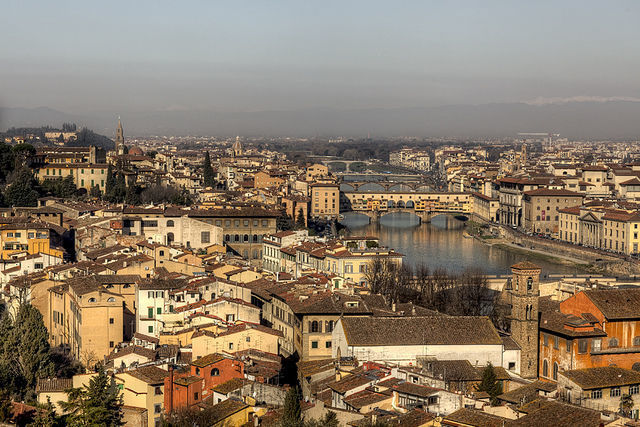Have you ever heard of the Diladdarno?
This is the name given by the Florentines to the Oltrarno district, the area of Florence situated on the left bank of the Arno river.
It includes the districts of Santo Spirito, San Frediano and San Niccolò, and is part of the historic center of Florence.
Even today, the Oltrarno district maintains more of the vitality of city life, in comparison with other districts. Many neighborhoods of the old town are in fact crowded with tourists and host mostly shops and restaurants.
In this neighborhood it is easier to find craft shops, food and the most tranquil squares to stop at for a break. This is also the area of the world famous restorers and antique shops.
We must remember that the Oltrarno district contains monuments, gardens, museums and palaces that are unique in the world, such as the Pitti Palace, the Basilica of Santo Spirito and the Boboli Gardens.
Already by Roman times, the predecessor of the Ponte Vecchio connected in the same place, the district of Oltrarno to the rest of the city.
By the Middle Ages, the city grew by incorporating many rural villages that were previously outside its walls. The Oltrarno district was the last to be closed within the final set of walls, and this, in 1333.
The beautiful Boboli Gardens and the Pitti Palace that we have come to know today were born on a rustic hillside, at that time outside city limits.
In fact, a drastic change occurred at the end of the fifth century when the wealthy Florentines began to consider this area as a place in which to build large lavish palaces and residences. The aim was to escape the unhealthy air and dirty alleys of the old city.
In 1865 the panoramic Piazzale Michelangelo was built in the Oltrarno district. It served as a new citizen meeting point, and the viale Machiavelli became the luxurious area of residence for the new upper class of the nineteenth and twentieth centuries.
Among the many monuments located in the Oltrarno, we must especially remember the Brancacci Chapel, the Cenacle of the Santo Spirito, the Church of San Felice in Piazza, the Church of San Jacopo Soprarno, the Basilica of San Miniato al Monte, the Church of Santa Felicita, the Church of Santa Maria del Carmine and the Church of San Frediano.
The Oltrarno district still contains many examples of Florentine military architecture, which manifests itself in the unique traits of Renaissance walls and fortified gates still intact today, such as the Porta Romana, Porta San Frediano, Porta San Giorgio, Porta San Miniato and Porta San Niccolò.
Florentines born or residing in this area are very proud of their neighborhood and defend it with force: while the city government has recently tried to bring mass tourism into even the most peaceful areas of Oltrarno, not all are in agreement…
Pictures by Giuseppe Moscato and Scott MacLead Liddle











I’d love to be on your mailing list! Thank you!
What are the street names where the craftsman shops and the antique shops are in the Oltrarno area?
thanks!
Hi Sylvia, for example Via Maggio but also all the small streets around. Here you find some independent shops http://girlinflorence.com/2014/09/11/where-to-shop-in-the-oltrarno/.